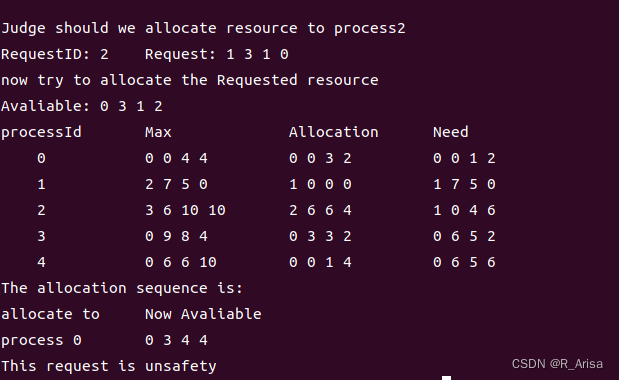关于银行家算法就不赘述了,首先是结果截图:


下面是代码:
#include <stdio.h>
#include <stdlib.h>
#include <string.h>
#define TRUE 1
#define FALSE 0
int N_resource, N_process; // 资源数和进程数
// 银行家算法用到的数据结构
int *Avaliable = NULL;
int **Max = NULL;
int **Allocation = NULL;
int **Need = NULL;
int requestID = 0; // 申请资源的进程ID
int *Request = NULL;
// 输入向量和矩阵
void input(FILE *fp) {
char buf[100];
// 输入N_resource and N_process
fgets(buf, 100, fp);
N_resource = atoi(strtok(buf, " "));
N_process = atoi(strtok(NULL, " "));
printf("%d resource %d process\n", N_resource, N_process);
// 输入Avaliable向量
Avaliable = (int *)malloc(sizeof(int) * N_resource);
fgets(buf, 100, fp);
Avaliable[0] = atoi(strtok(buf, " "));
for (int i = 1; i < N_resource; i++) {
Avaliable[i] = atoi(strtok(NULL, " "));
}
// 输入Max矩阵
Max = (int **)malloc(sizeof(int *) * N_process);
fgets(buf, 100, fp); // 跳过空行
for (int i = 0; i < N_process; i++) {
Max[i] = (int *)malloc(sizeof(int) * N_resource);
fgets(buf, 100, fp);
Max[i][0] = atoi(strtok(buf, " "));
for (int j = 1; j < N_resource; j++) {
Max[i][j] = atoi(strtok(NULL, " "));
}
}
// 输入Allocation矩阵
Allocation = (int **)malloc(sizeof(int *) * N_process);
fgets(buf, 100, fp); // 跳过空行
for (int i = 0; i < N_process; i++) {
Allocation[i] = (int *)malloc(sizeof(int) * N_resource);
fgets(buf, 100, fp);
Allocation[i][0] = atoi(strtok(buf, " "));
for (int j = 1; j < N_resource; j++) {
Allocation[i][j] = atoi(strtok(NULL, " "));
}
}
// 初始化Need矩阵
Need = (int **)malloc(sizeof(int *) * N_process);
for (int i = 0; i < N_process; i++) {
Need[i] = (int *)malloc(sizeof(int) * N_resource);
for (int j = 0; j < N_resource; j++)
Need[i][j] = Max[i][j] - Allocation[i][j];
}
// 输入requestID
fgets(buf, 100, fp); // 跳过空行
fgets(buf, 100, fp);
requestID = atoi(buf);
// 输入Request向量
Request = (int *)malloc(sizeof(int) * N_resource);
fgets(buf, 100, fp);
Request[0] = atoi(strtok(buf, " "));
for (int i = 1; i < N_resource; i++) {
Request[i] = atoi(strtok(NULL, " "));
}
}
// 打印当前状态
void print_state() {
printf("Avaliable: ");
for (int i = 0; i < N_resource; i++)
printf("%d ", Avaliable[i]);
printf("\n");
printf("processId\tMax\t\tAllocation\tNeed\n");
for (int i = 0; i < N_process; i++) {
printf(" %d\t\t", i);
for (int j = 0; j < N_resource; j++)
printf("%d ", Max[i][j]);
printf("\t");
for (int j = 0; j < N_resource; j++)
printf("%d ", Allocation[i][j]);
printf("\t");
for (int j = 0; j < N_resource; j++)
printf("%d ", Need[i][j]);
printf("\n");
}
}
// 判断是否所有的arrayA[i] <= arrayB[i]
int ALessthanB(int *arrayA, int *arrayB, int N) {
for (int i = 0; i < N; i++)
if (arrayA[i] > arrayB[i])
return FALSE;
return TRUE;
}
// 判断当前是否是安全状态
int isSafety() {
int *Work = malloc(sizeof(int) * N_resource);
int *Finish = malloc(sizeof(int) * N_process);
for (int i = 0; i < N_resource; i++)
Work[i] = Avaliable[i];
for (int i = 0; i < N_process; i++)
Finish[i] = FALSE;
printf("The allocation sequence is:\n");
printf("allocate to\tNow Avaliable\n");
for (int i = 0; i < N_process; i++) {
if (Finish[i] == TRUE)
continue;
int findit = FALSE;
for (int j = 0; j < N_resource; j++) {
// 对于该进程i,判断是否所有资源Need[i][j] <= Work[j]
if (ALessthanB(Need[i], Work, N_resource)) {
findit = TRUE;
break;
}
}
if (findit) {
for (int j = 0; j < N_resource; j++)
Work[j] += Allocation[i][j];
Finish[i] = TRUE;
// 打印安全序列的判断路径
printf("process %d\t", i);
for (int j = 0; j < N_resource; j++)
printf("%d ", Work[j]);
printf("\n");
// 重新搜索
i = -1;
}
}
free(Work);
// 判断是否所有的Finish[i]都是TRUE
for (int i = 0; i < N_process; i++) {
if (Finish[i] == FALSE) {
free(Finish);
return FALSE;
}
}
free(Finish);
return TRUE;
}
// int ID,是申请资源的进程ID
// 判断是否允许该进程的申请
int allowRequest(int ID) {
// print the Request array
printf("RequestID: %d\tRequest: ", requestID);
for (int i = 0; i < N_resource; i++)
printf("%d ", Request[i]);
printf("\n");
if (!ALessthanB(Request, Need[ID], N_resource)) {
printf("Error: Request <= Need\n");
return FALSE;
}
if (!ALessthanB(Request, Avaliable, N_resource)) {
printf("Error: Request <= Avaliable\n");
return FALSE;
}
// 尝试分配申请的资源
for (int i = 0; i < N_resource; i++) {
Avaliable[i] -= Request[i];
Allocation[ID][i] += Request[i];
Need[ID][i] -= Request[i];
}
printf("now try to allocate the Requested resource\n");
print_state();
if (isSafety())
return TRUE;
else {
// 不能允许该申请,恢复原先的数据结构
for (int i = 0; i < N_resource; i++) {
Avaliable[i] += Request[i];
Allocation[ID][i] -= Request[i];
Need[ID][i] += Request[i];
}
return FALSE;
}
}
/*
* 测试文件的格式为:
* 资源数 进程数
* Avaliable向量
*
* Max矩阵
*
* Allocation矩阵
*
* 申请资源的进程ID
* Request向量
*/
int main(int argc, char *argv[]) {
FILE *fp = NULL;
if ((fp = fopen(argv[1], "r")) == NULL) {
printf("%s: No such file or directory\n", argv[1]);
return 0;
}
input(fp);
printf("The inisialized state is:\n");
print_state();
printf("Judge whether the inisialized state is safety:\n");
if (isSafety())
printf("The inisialized state is safety\n\n");
else
printf("The inisialized state is unsafety\n\n");
printf("Judge should we allocate resource to process%d\n", requestID);
if (allowRequest(requestID))
printf("This request is safety\n");
else
printf("This request is unsafety\n");
// 释放内存
for (int i = 0; i < N_process; i++) {
free(Max[i]); free(Allocation[i]); free(Need[i]);
}
free(Avaliable); free(Max);
free(Allocation); free(Need);
return 0;
}
测试用例是:
4 5
1 6 2 2
0 0 4 4
2 7 5 0
3 6 10 10
0 9 8 4
0 6 6 10
0 0 3 2
1 0 0 0
1 3 5 4
0 3 3 2
0 0 1 4
2
1 3 1 0






















 1万+
1万+











 被折叠的 条评论
为什么被折叠?
被折叠的 条评论
为什么被折叠?








